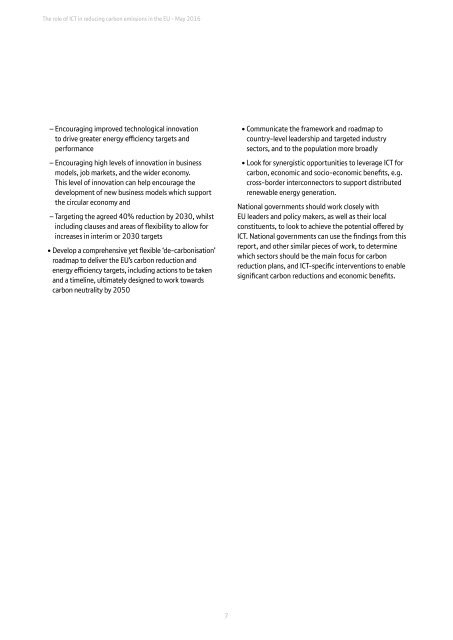The role of ICT in reducing carbon emissions in the EU
ICT_Carbon_Reduction_EU
ICT_Carbon_Reduction_EU
Create successful ePaper yourself
Turn your PDF publications into a flip-book with our unique Google optimized e-Paper software.
<strong>The</strong> <strong>role</strong> <strong>of</strong> <strong>ICT</strong> <strong>in</strong> reduc<strong>in</strong>g <strong>carbon</strong> <strong>emissions</strong> <strong>in</strong> <strong>the</strong> <strong>EU</strong> - May 2016<br />
– Encourag<strong>in</strong>g improved technological <strong>in</strong>novation<br />
to drive greater energy efficiency targets and<br />
performance<br />
– Encourag<strong>in</strong>g high levels <strong>of</strong> <strong>in</strong>novation <strong>in</strong> bus<strong>in</strong>ess<br />
models, job markets, and <strong>the</strong> wider economy.<br />
This level <strong>of</strong> <strong>in</strong>novation can help encourage <strong>the</strong><br />
development <strong>of</strong> new bus<strong>in</strong>ess models which support<br />
<strong>the</strong> circular economy and<br />
– Target<strong>in</strong>g <strong>the</strong> agreed 40% reduction by 2030, whilst<br />
<strong>in</strong>clud<strong>in</strong>g clauses and areas <strong>of</strong> flexibility to allow for<br />
<strong>in</strong>creases <strong>in</strong> <strong>in</strong>terim or 2030 targets<br />
• Develop a comprehensive yet flexible ‘de-<strong>carbon</strong>isation’<br />
roadmap to deliver <strong>the</strong> <strong>EU</strong>’s <strong>carbon</strong> reduction and<br />
energy efficiency targets, <strong>in</strong>clud<strong>in</strong>g actions to be taken<br />
and a timel<strong>in</strong>e, ultimately designed to work towards<br />
<strong>carbon</strong> neutrality by 2050<br />
• Communicate <strong>the</strong> framework and roadmap to<br />
country-level leadership and targeted <strong>in</strong>dustry<br />
sectors, and to <strong>the</strong> population more broadly<br />
• Look for synergistic opportunities to leverage <strong>ICT</strong> for<br />
<strong>carbon</strong>, economic and socio-economic benefits, e.g.<br />
cross-border <strong>in</strong>terconnectors to support distributed<br />
renewable energy generation.<br />
National governments should work closely with<br />
<strong>EU</strong> leaders and policy makers, as well as <strong>the</strong>ir local<br />
constituents, to look to achieve <strong>the</strong> potential <strong>of</strong>fered by<br />
<strong>ICT</strong>. National governments can use <strong>the</strong> f<strong>in</strong>d<strong>in</strong>gs from this<br />
report, and o<strong>the</strong>r similar pieces <strong>of</strong> work, to determ<strong>in</strong>e<br />
which sectors should be <strong>the</strong> ma<strong>in</strong> focus for <strong>carbon</strong><br />
reduction plans, and <strong>ICT</strong>-specific <strong>in</strong>terventions to enable<br />
significant <strong>carbon</strong> reductions and economic benefits.<br />
7


